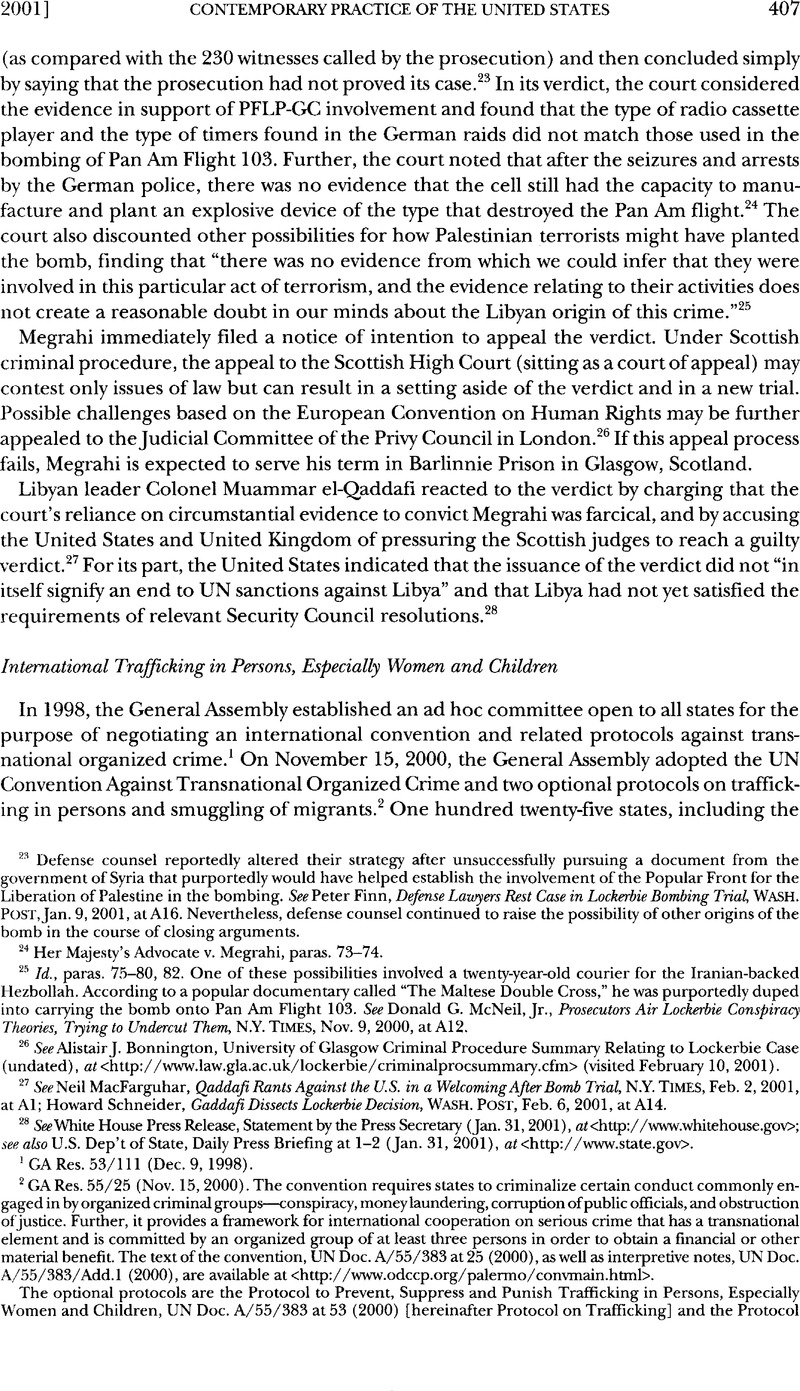Article contents
International Trafficking in Persons, Especially Women and Children
Published online by Cambridge University Press: 10 March 2017
Abstract

- Type
- Contemporary Practice of the United States Relating to International Law
- Information
- Copyright
- Copyright © American Society of International Law 2001
References
1 GA Res. 53/111 (Dec. 9, 1998).
2 GA Res. 55/25 (Nov. 15, 2000). The convention requires states to criminalize certain conduct commonly engaged in by organized criminal groups—conspiracy, money laundering, corruption of public officials, and obstruction of justice. Further, it provides a framework for international cooperation on serious crime that has a transnational element and is committed by an organized group of at least three persons in order to obtain a financial or other material benefit. The text of the convention, UN Doc. A/55/383 at 25 (2000), as well as interpretive notes, UN Doc. A/55/383/Add.l (2000), are available at <http://www.odccp.org/palermo/convmain.html>.
The optional protocols are the Protocol to Prevent, Suppress and Punish Trafficking in Persons, Especially Women and Children, UN Doc. A/55/383 at 53 (2000) [hereinafter Protocol on Trafficking] and the Protocol Against the Smuggling of Migrants by Land, Sea and Air, UN Doc. A/55/383 at 62. A third protocol—dealing with the illicit manufacturing of, and trafficking in, firearms—remains under negotiation.
3 Protocol on Trafficking, supra note 2, Art. 3. Significantly, the protocol provides that the consent of a victim to such exploitation is irrelevant if any of the means set forth in the definition have been used, and that exploitation of a child (under 18 years of age) is trafficking even if it does not involve any of the means set forth in the definition. Id. The interpretive notes indicate that where illegal adoption amounts to a practice similar to slavery, as that term is defined in international instruments, it will fall within the definition of trafficking.
4 In the United States, women’s groups, family-planning advocates, and conservative groups all supported the negotiation of a strong protocol. See, e.g., Shenon, Philip, Feminist Coalition Protests U.S. Stance on Sex Trafficking Treaty, N.Y. Times, Jan. 13, 2000, at A5.Google Scholar
5 146 Cong. Rec. H2675-82 (daily ed. May 9, 2000).
6 146 Cong. Rec. S7781 (daily ed. July 27, 2000).
7 Pub. L. No. 106-386, §§101-113, 114 Stat. 1464, 1466-91 (2000). For legislative history, see the conference report, H.R. Conf. Rep. NO. 939, 106th Cong., 2d Sess., at 88-102 (2000).
8 Trafficking Victims Protection Act of 2000 §102. Since few prior U.S. federal and state laws were aimed directly at trafficking in persons, prosecutors often had to assemble cases using more general laws on document fraud or on transporting persons in interstate commerce for purposes of prostitution, which often entailed relatively light penalties. See Schmitt, Eric & Brinkley, Joel, House Passes Bill to Toughen Laws on Forced Labor, N.Y. Times, Oct. 7, 2000, at A1.Google Scholar Alternatively, traffickers could be prosecuted under antislavery statutes, but those statutes have a more difficult burden of proof than the new legislation.
9 Trafficking Victims Protection Act of 2000 §104.
10 Id. §108.
11 Id. §109.
12 Id. §U0.
13 50 U.S.C. §§1701-1706 (1994). The secretary of state is exempt, however, from the requirement of the International Emergency Economic Powers Act that such sanctions be imposed only in cases where the president has declared a national emergency.
14 Trafficking Victims Protection Act of 2000 §111.
15 Id. §112.
16 Id. §106.
17 Id. §107(a).
18 Id. §107(b)-(e).
19 Id. §107(e).
20 Id. §105.
21 Id. §113.
- 1
- Cited by




